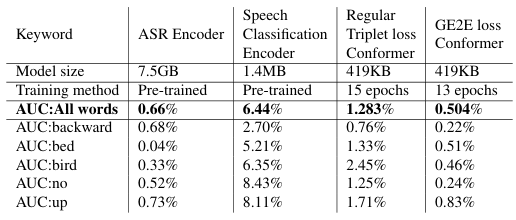GE2E-KWS: Generalized End-to-End Training and Evaluation for Zero-shot Keyword Spotting
Pai Zhu, Jacob W. Bartel, Dhruuv Agarwal, Kurt Partridge, Hyun Jin Park, Quan Wang·October 22, 2024
Summary
GE2E-KWS is a custom keyword spotting framework using speech embeddings for enrollment and serving, enhancing convergence stability and training speed. It surpasses triplet loss approaches, offering low memory footprints and continuous on-device operation. Models like the GE2E conformer outperform large ASR encoders, achieving zero-shot detection for new keywords. The paper introduces the application of generalized end-to-end loss for KWS tasks, addressing limitations in previous methods and improving efficiency. The GE2E conformer model, optimized for performance and size, achieves a 23.6% improvement in AUC over a 7.5GB ASR encoder. The text discusses various models for speech recognition, focusing on the DET curve, AUC, and EER metrics, highlighting the GE2E conformer's superior performance.
Introduction
Background
Overview of keyword spotting (KWS) systems
Importance of speech embeddings in KWS
Challenges in traditional KWS approaches
Objective
To present GE2E-KWS, a novel framework for KWS using speech embeddings
Highlight improvements in convergence stability, training speed, and memory footprint
Demonstrate superior performance compared to triplet loss approaches
Method
Data Collection
Techniques for collecting speech data for enrollment and serving
Data Preprocessing
Methods for preparing data for the GE2E-KWS framework
Importance of preprocessing in enhancing model performance
GE2E Conformer Model
Description of the GE2E conformer model
How it surpasses large ASR encoders in performance and size
Explanation of zero-shot detection capability for new keywords
Generalized End-to-End Loss
Introduction to the generalized end-to-end loss for KWS tasks
How it addresses limitations in previous methods
Benefits in terms of efficiency and effectiveness
Performance Evaluation
DET Curve, AUC, and EER Metrics
Explanation of DET curve, AUC, and EER as performance indicators for speech recognition systems
How these metrics are applied in the context of GE2E-KWS
GE2E Conformer Model Performance
Detailed analysis of the GE2E conformer model's performance
Comparison with a 7.5GB ASR encoder in terms of AUC improvement (23.6%)
Conclusion
Summary of GE2E-KWS
Recap of the framework's key features and benefits
Future Directions
Potential areas for further research and development
Opportunities for integrating GE2E-KWS in real-world applications
Basic info
papers
audio and speech processing
machine learning
artificial intelligence
Advanced features
Insights
What are the key advantages of using the GE2E conformer model over large ASR encoders?
What is the main focus of the GE2E-KWS framework?
How does the GE2E-KWS framework demonstrate its performance superiority in the context of speech recognition tasks?
How does the GE2E-KWS framework improve upon triplet loss approaches?


